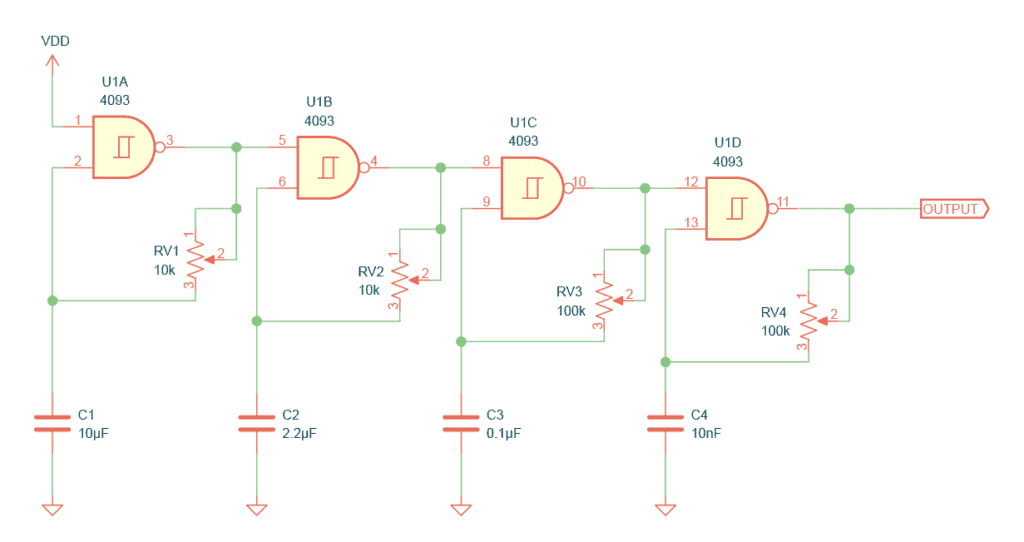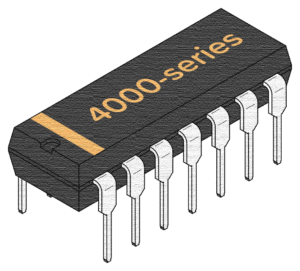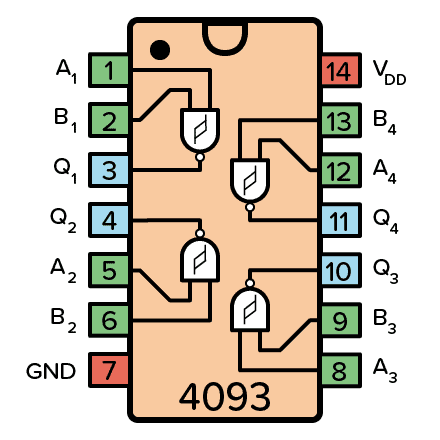
The CD4093 is a CMOS chip with four NAND gates with Schmitt trigger. Because each gate has two inputs and it has four gates inside, it’s often referred to as a Quad 2-Input NAND Schmitt Trigger.
A NAND gate with Schmitt trigger works more or less like a normal NAND gate. With the exception that the threshold for when it switches from LOW to HIGH is different from when it switches from HIGH to LOW.
Pin Overview
| Pin Name | Pin # | Type | Description |
|---|---|---|---|
| VDD | 14 | Power | Supply Voltage (+3 to +15V) |
| GND | 7 | Power | Ground (0V) |
| A1 to A4 | 1, 5, 8, 12 | Input | Inputs A of the four NAND gates |
| B1 to B4 | 2, 6, 9, 13 | Input | Inputs B of the four NAND gates |
| Q1 to Q4 | 3, 4, 10, 11 | Output | Outputs from the four NAND gates |
What is a NAND gate with Schmitt Trigger?
First of all, a NAND gate is a logic gate that works like an AND gate with a NOT gate on the output. Therefore it’s often called NOT-AND.
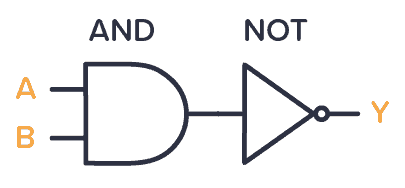
This means that a NAND gate gives a LOW output only when all inputs are HIGH as shown in the truth table below.
| Input A | Input B | Output Q |
|---|---|---|
| 0 | 0 | 1 |
| 1 | 0 | 1 |
| 0 | 1 | 1 |
| 1 | 1 | 0 |
Schmitt Trigger
But this is a Schmitt trigger NAND gate. What does that mean?
This has to do with at what voltage the gate will interpret the input as a LOW or a HIGH input:
For example for a normal (non-Schmitt Trigger) gate that is powered from 5V, the gate might say that any voltage above 2.5V is HIGH, and any voltage below 2.5V is LOW. So if the input is at 2.5V and swinging a bit up and down (as these signals tend to do), then the output would be uncertain.
2.5V would be the threshold voltage.
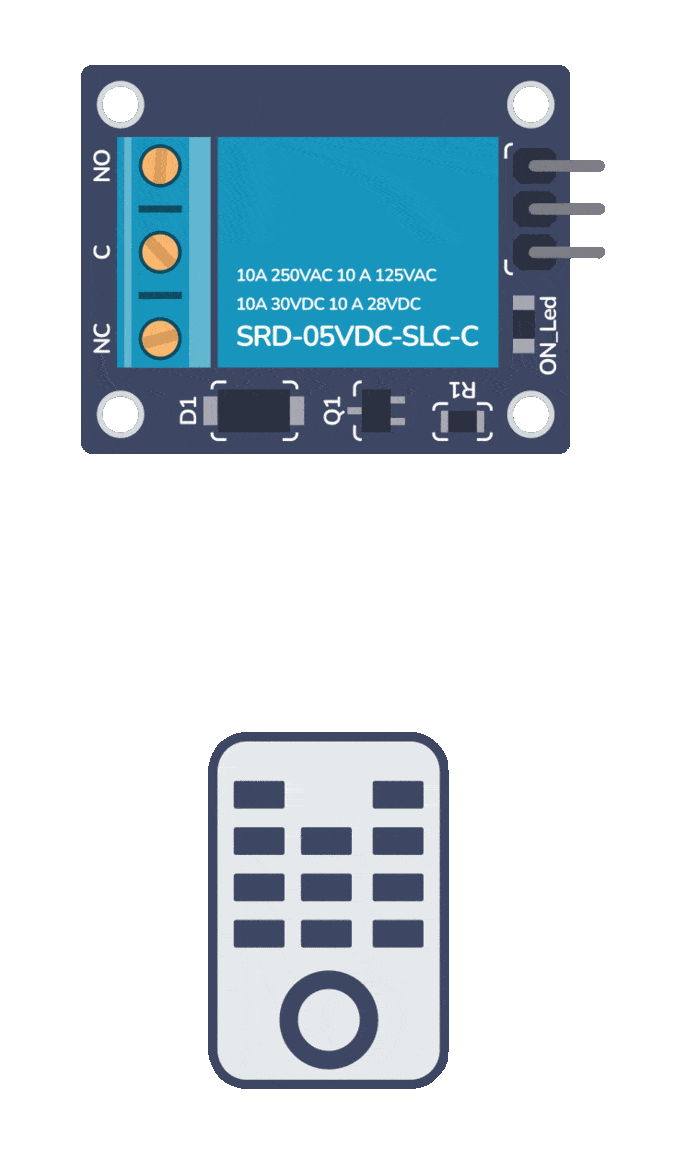
Build Something Useful This Evening
This gadget lets you use any IR remote-control to control your lamp, garden lights, heater oven, garage door, or anything else.
But for a Schmitt trigger gate, the threshold voltage is different based on if the input changes from LOW to HIGH or from HIGH to LOW.
For example, if the input is currently LOW, then a Schmitt trigger gate might require the input voltage to go above for 3.5V to switch to HIGH. But when it has switched to HIGH, dropping a bit below 3.5V doesn’t matter. Because in order to switch back to LOW, the Schmitt trigger gate requires the input to go down below for example 1.5V.
How To Use the CD4093?
First of all, you need a power supply voltage of 3 to 15V. Some versions of the chip support up to 20V. Check the datasheet of your version of the chip for exact values.
To be able to use any of the NAND gates in the chip, you need to first connect the VDD pin to the positive supply terminal and the GND pin to the negative supply terminal.
The A and B pins are the inputs to the four NAND gates in the IC.
The Q pins are the outputs from the NAND gates.

CD4093 Example Circuit – Old-School Computer Sounding Synth
This is a really cool circuit that uses the four NAND gates in the chip to create four oscillators that are connected in series. Each oscillator has a capacitor and a potentiometer that you can use to adjust the frequency. This creates a really cool old-school computer type of sound.
The first oscillator is the slowest. It turns all the others on and off at a slow speed. Then the next one is a bit faster. Then the third one is even faster. And the fourth one is the fastest.
I found this circuit over at Andreas Siagian’s website and I recommend you check out his site for more information and a video example of the circuit in use. And it looks like the original source is from fluxmonkey.com (which is also a really good resource to check out).
To build this you’ll need:
- A chip with NAND Schmitt Trigger gates such as the CD4093BE
- 10 µF Capacitor (C1)
- 2.2 µF Capacitor (C2)
- 0.1 µF Capacitor (C3)
- 10 nF Capacitor (C4)
- Four potentiometers in the range 10 kΩ to 100kΩ (RV1-RV4)
Plug the output into an amplifier (or a passive piezo buzzer) to hear the result.
Alternatives and Equivalents for CD4093
You likely find the 4093 IC marked as CD4093, NTE4093, MC14093, HCF4093, TC4093, or HEF4093. Usually with a few extra characters at the end (Ex: CD4093BE).
This has to do with the manufacturer of the chip and the technology used. But the functionality and the pins are the same.
If they don’t have any of these chips in your local electronics store, check out my list of online stores where you can find components and tools for all your electronics projects.
Can’t find the 4093? Then try one of the following IC alternatives with 2-input NAND Schmitt trigger gates:
- 74HC132: Quad 2-input NAND Schmitt Trigger
4093 Datasheet
Download the PDF datasheet for the IC 4093 here:
CD4093B (Texas Instruments)
HEF4093B (Nexperia)
Go back to the full overview of the 4000-series integrated circuits

10 Simple Steps to Learn Electronics
Electronics is easy when you know what to focus on and what to ignore. Learn what "the basics" really is and how to learn it fast.

